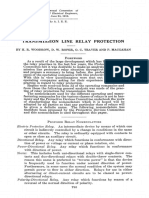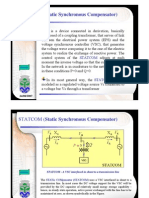Triggered Voltage Vs Sphere Gap Distance
Triggered Voltage Vs Sphere Gap Distance
Uploaded by
prabodh119Copyright:
Available Formats
Triggered Voltage Vs Sphere Gap Distance
Triggered Voltage Vs Sphere Gap Distance
Uploaded by
prabodh119Original Description:
Original Title
Copyright
Available Formats
Share this document
Did you find this document useful?
Is this content inappropriate?
Copyright:
Available Formats
Triggered Voltage Vs Sphere Gap Distance
Triggered Voltage Vs Sphere Gap Distance
Uploaded by
prabodh119Copyright:
Available Formats
Graph of the Triggered Voltage Vs Sphere Gaps:
0
20
40
60
80
100
120
140
160
180
200
0 0.5 1 1.5 2 2.5 3 3.5 4 4.5
T
r
i
g
g
e
r
e
d
V
o
l
t
a
g
e
(
k
V
)
Gap distance (cm)
Triggered Voltage Vs Sphere Gap Distance
CALCULATIONS
C
S
Surge Capacitance
C
0
Shunt Capacitance
R
1D
Internal Damping Resistance
R
1
Charging Resistance
R
OUT
Wave Tail Resistance
O =
=
O =
=
=
= = =
k
R
R
F C
F C C
OUT
O
S
1.4286
5000 // 2000
270
180 + 15 6
003 . 0
042 . 0
6
25 . 0
6 /
1
1
- Efficiency
93.3% 0.933
003 . 0 042 . 0
042 . 0
1
1
= =
+
=
+
=
O
C C
C
q
- Wavefront time
Wave front is considered from 30% to 90%
s 18.15 T
10 003 . 0 10 2 933 . 0 3.243 T
C R 3.243 T
r
6 3
r
O OUT r
q
=
=
=
- Wavatail time
.623ms 0 T
933 . 0
10 042 . 0 10 0 2 0.693
T
C R 0.693
T
r
6 3
r
S OUT
r
=
=
=
q
- Stored Energy at Maximum Voltage
Maximum Voltage
kV E
E
C C
C
V E
O
280
003 . 0 042 . 0
042 . 0
300
max
max
1
1
max max
=
+
=
+
=
Maximum Energy
2007.6 J
- Peak inverse voltage of the diode
Peak inverse voltage of the diode = 30 kV
= 51.96kV
DISCUSSION
Difference between the practical values and theoretical values:
Wave tail time
Theoretical value = 44.57
Practical value =
The difference between the theoretical values and practical values may be due to following reasons.
- Human errors.
- Calculation errors.
- The ionization can be caused to change the breakdown strength of air while doing the practical.
- The resistance of the connecting wires are neglected
- There can be slight variations in the capacitor values and charging resistor values.
- As a result of aging, temperature and usage the wave front and wave tail control resistances can be
changed.
- Theoretically impulse generator should produce 300kV, but practically the capacitors are not all
charged to the same voltage due to the resistances that are in series during charging.
Use of impulse generator:
In order that equipment designed to be used on high voltage lines, and others, be able to withstand
surges caused in them during operation, it is necessary to test these equipment with voltages of the form
likely to be met in service. Impulse test systems are used to generate impulse voltages simulating
lightning strokes and switching surges.The Impulse Voltage Generator is the main part of an impulse
voltage test system. It consists of capacitors, resistors, and spark gaps. Some of its applications are
listed below.
Lightning testing on cables and insulators
Material and dielectric testing
Breaking of raw diamonds in mineralogy
Bridge wire exploding
Electron injection into nuclear reactors
Electron accelerators
Flash x-ray generation
Pulsed electron generation
Short duration luminous flash for ultra high speed photography
Nuclear electromagnetic pulse generator
Generation of axial plasma for injection purposes
Produced impulse voltage
Theoretical value = 300 kV
Practical value = 280 kV
Charging and Discharging Process of the Impulse Generator:
The impulse voltage generator consists of capacitors, resistors, and spark gaps.
The charging circuit consists of a high voltage step up transformer and a full bridge rectifier which
is used to provide HVDC supply to the capacitors.
The full wave bridge circuit has better voltage regulation characteristics than voltage doublers
circuits and does not require any capacitors for voltage doubling.
A stack of capacitors is simultaneously charged in a parallel configuration to a voltage "E" and then
discharged in series with a voltage of "nE" where "n" in the number of capacitors chargedin order to
obtain a higher impulse voltage.
The discharge of capacitors occurs through a special preciselyspaced spark gap switches for each
capacitor.
The breakdown of the controlling sphere gap occurs first and it initiates the triggering of the other
sphere gap.
By changing the gap distance between the controlling spheres, it is possible to change the
magnitude of the breakdown voltage.
Operation of impulse generator:
I. Uncontrolled operation
In the uncontrolled operation, the break down voltage of the sphere gap is less than the peak value
of the supply, so that it discharges as the voltage across the gap builds up above its breakdown
value.
Hence the capacitor most probably discharges through the impulse generator circuit while
producing an impulse waveform.
The impedance of the impulse generator circuit is much lower than that of the impulse generator
charging circuit. Therefore the rectifier and other related components could be disregarded during
the impulse.
The capacitor would charge up once again and the process would be repetitive.
Both the time of occurrence of the impulse or the exact magnitude are not controllable, as the
breakdown of a sphere gap is not exactly a constant but statistical.
,.
C
2
C
1
R
1
Diode Sphere gap
a.c.
supply
h.v.
transformer
R
2
e
II. Controlled operation
In controllable method charging voltage is less than the spark over voltage.
The capacitor is permitted to reach the full charging voltage without the breaking down of the
sphere gap, though the same basic circuit is used,.
The spark over voltage is arranged at a slightly higher value than the charging voltage.
That is facilitated by a special arrangement of third sphere in between the other two, to be able to
initiate breakdown of the gap.
The potential across the main gap is divided into two by means of 2 equal resistors R, each of about
100 M. Hence half the applied voltage V appears across each of the two auxiliary gaps.
Once the capacitor C
1
has charged up to the full value, a small pulse voltage v(about 20 %)is applied
at the third electrode (also known as the trigger electrode).
Impulse generator waveforms for uncontrolled operation
C
2
C
1
R
1
Diode Sphere gap
a.c.
supply
h.v. transformer
R
2
Pulse v
e
R R
This pulse raises the voltage across one of the auxiliary gaps to more than half the charging voltage
(V + v) so that it would be just sufficient to breakdown the gap.
As this auxiliary gap breaks down, the full voltage would be applied across the remaining auxiliary
gap causing it also to breakdown.
Once both auxiliary gaps have broken down, the ionization present in the region would cause the
main gap also to breakdown almost simultaneously and thus the impulse voltage would be applied.
Impulse generator waveforms for controlled operation
Control Panel:
This is used to increase the input voltage to the impulse generator unil the breakdown occurs. There is
a voltmeter and an ammeter to take the readings of input current and input voltage.
Important Features of oscilloscopes:
- Impulse waveforms have characteristics, which are changing vary rapidly, mostly in the order of
micro seconds. So the sampling frequency of the oscilloscope should be high enough to capture the
waveform with a greater accuracy.
- It should also have fairly adequate storage capacity.
Observed waveform
References:
High Voltage Engineering by Prof: J. Rohan Lucas
V measuring potential device
Impulse
generat
or
Chargin
g unit
Control
Panel
You might also like
- Impulse Generator Practical Course WorkDocument8 pagesImpulse Generator Practical Course WorkKapila Kumara100% (1)
- To Study The Open Circuit/Core Losses of Single Phase TransformerDocument5 pagesTo Study The Open Circuit/Core Losses of Single Phase TransformerTanzeel UR RehmanNo ratings yet
- Adjustable Speed Induction Motor DriveDocument20 pagesAdjustable Speed Induction Motor DrivePathum SudasingheNo ratings yet
- Measurement of High Voltages and CurrentsDocument35 pagesMeasurement of High Voltages and Currentssyed1188No ratings yet
- IEEE-Commutation Failures in HVDC TX SystemsDocument12 pagesIEEE-Commutation Failures in HVDC TX SystemsGustavo AguayoNo ratings yet
- Grounding Transformer 1Document4 pagesGrounding Transformer 1MauricioNo ratings yet
- Power TransformersDocument37 pagesPower TransformersGanesuni Harish100% (1)
- OLTC - Circulating CurrentDocument16 pagesOLTC - Circulating CurrentAsif MominNo ratings yet
- HV Impulse Test Systems: Lightning Impulse Chopped Lightning Impulse Switching Impulse Fast TransientDocument3 pagesHV Impulse Test Systems: Lightning Impulse Chopped Lightning Impulse Switching Impulse Fast Transientchaima haddoudiNo ratings yet
- Voltage RegulatorDocument60 pagesVoltage RegulatorJunry Tatoy MonterolaNo ratings yet
- Parallel Operation of TransformersDocument10 pagesParallel Operation of TransformersMMK29100% (1)
- Transformer Routine Test - Measurement of No-Load Loss and CurrentDocument4 pagesTransformer Routine Test - Measurement of No-Load Loss and Currentjob_pNo ratings yet
- IEEE 1124 2003 Guide For Analysis and Definition of DC Side Harmonic Performance of HVDC Transmission SystemsDocument77 pagesIEEE 1124 2003 Guide For Analysis and Definition of DC Side Harmonic Performance of HVDC Transmission SystemsscribdNo ratings yet
- Anti Condensation Heaters March 2011Document52 pagesAnti Condensation Heaters March 2011SandeepNo ratings yet
- Upptcl Intern PDFDocument24 pagesUpptcl Intern PDFnischaljain07No ratings yet
- Transformer Losses Calculation (As Per Transformer Test Results)Document2 pagesTransformer Losses Calculation (As Per Transformer Test Results)Krisna Bayu AriyantoNo ratings yet
- UNIT-4: HarmonicsDocument23 pagesUNIT-4: HarmonicsAditya Vittal100% (1)
- Advanced Paralleling of LTC Transformers by The Circulating Current MethodDocument18 pagesAdvanced Paralleling of LTC Transformers by The Circulating Current MethodBalu MNo ratings yet
- 4 Essential Features of Transformer On-Load Tap Changer OLTCDocument5 pages4 Essential Features of Transformer On-Load Tap Changer OLTCrobertoseniorNo ratings yet
- What Is Tap ChangerDocument42 pagesWhat Is Tap ChangerThức Võ100% (2)
- Autotransformer and Variable Auto Transformer PDFDocument6 pagesAutotransformer and Variable Auto Transformer PDFaesthetepkNo ratings yet
- A.C Powers and Power FactorDocument23 pagesA.C Powers and Power Factoremg100% (1)
- Transformer NotesDocument36 pagesTransformer NotesYouTuBoy AmanNo ratings yet
- Digital Static Excitation SystemDocument16 pagesDigital Static Excitation SystemHộpQuà TriÂnNo ratings yet
- Емкостной делитель SMC 6000-100 кВDocument4 pagesЕмкостной делитель SMC 6000-100 кВ4nam1No ratings yet
- LL SgdaDocument20 pagesLL SgdapetarlNo ratings yet
- Transmission Line Relay ProtectionDocument32 pagesTransmission Line Relay ProtectionRogelio RevettiNo ratings yet
- HM Oltc PDFDocument42 pagesHM Oltc PDFfaith37100% (1)
- Hitachi Energy MV Surge Arrester Application GuidelinesDocument31 pagesHitachi Energy MV Surge Arrester Application GuidelinesAmany HamdyNo ratings yet
- Stat ComDocument13 pagesStat ComSanthi Manoj VaddiNo ratings yet
- Capacitor BanksDocument49 pagesCapacitor BanksAmal P Ravi100% (1)
- Chap3 - 1 Power Measurement PDFDocument22 pagesChap3 - 1 Power Measurement PDFTiffanyNo ratings yet
- Transformer FAQsDocument1 pageTransformer FAQsamitdhamija100% (1)
- Ieee - HVDC & FactsDocument7 pagesIeee - HVDC & FactsKarthik SekarNo ratings yet
- Voltage & Current ImbalancesDocument12 pagesVoltage & Current ImbalancesMohit Gauttam100% (1)
- Measurement High Voltage (Spark Gaps)Document6 pagesMeasurement High Voltage (Spark Gaps)L Rahman AliffiantoNo ratings yet
- HV Transformers Factory Test Oct 8 9 PDFDocument27 pagesHV Transformers Factory Test Oct 8 9 PDFVikas GuptaNo ratings yet
- 3 10 4Document4 pages3 10 4Mohammed AbdelsalamNo ratings yet
- CT and PTDocument3 pagesCT and PTrk_mbdNo ratings yet
- Zero-Phase Filtering For Lightning Impulse EvaluatDocument11 pagesZero-Phase Filtering For Lightning Impulse EvaluatMB AshrafNo ratings yet
- Commissioning Numerical RelaysDocument24 pagesCommissioning Numerical RelaysVHMANOHARNo ratings yet
- Transfomer No Load Current HarmonicsDocument6 pagesTransfomer No Load Current HarmonicsДејан ПејовскиNo ratings yet
- CM OLTC Operating Instruction-HM0.460.301Document45 pagesCM OLTC Operating Instruction-HM0.460.301zakirul islamNo ratings yet
- Chapter 3 - CT&VT - Part 2Document34 pagesChapter 3 - CT&VT - Part 2zhafranNo ratings yet
- Impact of Static Var Compensator (SVC) Installation in Power System StabilityDocument7 pagesImpact of Static Var Compensator (SVC) Installation in Power System Stabilityboody bazaraaNo ratings yet
- Module4 TransformerDocument47 pagesModule4 Transformeranvay.shirsatNo ratings yet
- Transformer OLTC Control in Power SystemsDocument12 pagesTransformer OLTC Control in Power SystemsIndiranInNo ratings yet
- Is.2705.4.1992 - Current Transformers, Part 4Document11 pagesIs.2705.4.1992 - Current Transformers, Part 4Sugun Kumar PedapudiNo ratings yet
- Testing of TransformerDocument37 pagesTesting of TransformerVikas GuptaNo ratings yet
- PTs-Back To The BasicsDocument11 pagesPTs-Back To The BasicssarangNo ratings yet
- Right Choice of Dry Type or Liquid-Filled TransformerDocument7 pagesRight Choice of Dry Type or Liquid-Filled TransformerEngr. AbdullahNo ratings yet
- Digital - Relaying - PPT PDFDocument39 pagesDigital - Relaying - PPT PDFnemarjeltnNo ratings yet
- Metal Enclosed Switched Shunt Reactor BanksDocument13 pagesMetal Enclosed Switched Shunt Reactor BanksaramirezbenitesNo ratings yet
- Hdian Standard: Current Transformers - SpecificationDocument9 pagesHdian Standard: Current Transformers - Specificationvenkat8eNo ratings yet
- Per-Unit System2009-3Document26 pagesPer-Unit System2009-3Akinbode Sunday Oluwagbenga100% (1)
- GE2011 IbDocument152 pagesGE2011 IbEsteban SosaNo ratings yet
- High Voltage Impulse GeneratorDocument10 pagesHigh Voltage Impulse GeneratorRoshan AkaravitaNo ratings yet
- Triggered Voltage Vs Sphere Gap DistanceDocument7 pagesTriggered Voltage Vs Sphere Gap DistancesachinthaNo ratings yet
- High Voltage Impulse GeneratorDocument10 pagesHigh Voltage Impulse GeneratorosddsNo ratings yet
- High Voltage Impulse GeneratorDocument7 pagesHigh Voltage Impulse Generatorudnuwan100% (1)
- Re - 1990-12Document90 pagesRe - 1990-12Anonymous kdqf49qb100% (2)
- Analysis of Multi-Layer Polymer Films: ExperimentalDocument2 pagesAnalysis of Multi-Layer Polymer Films: ExperimentalClaudio Moretto JuniorNo ratings yet
- After The Basics A 3D Printing HandbookDocument49 pagesAfter The Basics A 3D Printing HandbookMarcio José de Oliveira67% (3)
- Iris Fixation of Unstable Anterior Chamber Intraocular LensesDocument4 pagesIris Fixation of Unstable Anterior Chamber Intraocular LensesJhun EjuNo ratings yet
- DURIT Thermal-CoatingsDocument8 pagesDURIT Thermal-CoatingsMatheusNo ratings yet
- Raman ThesisDocument8 pagesRaman Thesisafbtmznam100% (2)
- FFG - The Mandalorian War MachineDocument7 pagesFFG - The Mandalorian War MachineChristian VikströmNo ratings yet
- Fallout Unwashed Assets Monsters and NpcsDocument4 pagesFallout Unwashed Assets Monsters and NpcsVeritas VeritatiNo ratings yet
- Sony HCD Dx70Document72 pagesSony HCD Dx70parascoliNo ratings yet
- Michelson Interefrometer Viva QuestionsDocument2 pagesMichelson Interefrometer Viva QuestionsDhruv NagarNo ratings yet
- Leaflet Labels SRA3Document2 pagesLeaflet Labels SRA3So DurstNo ratings yet
- rfg045667 PDFDocument475 pagesrfg045667 PDFCopyzoom PlusNo ratings yet
- FANUC LASER-MODEL C1000iA - Operators Manual - 015096Document107 pagesFANUC LASER-MODEL C1000iA - Operators Manual - 015096kocho79No ratings yet
- Improved Mining SafetyDocument28 pagesImproved Mining SafetyKarthick VijayanNo ratings yet
- Introduction To Solid State Devices, Examples and ApplicationsDocument21 pagesIntroduction To Solid State Devices, Examples and ApplicationsMD. MEHEDI HASANNo ratings yet
- Inspection, Test, Marking and RecordsDocument10 pagesInspection, Test, Marking and RecordssuryaNo ratings yet
- Machining and Joining of Composites: Syed Basith MuzammilDocument20 pagesMachining and Joining of Composites: Syed Basith MuzammilSyed BasithNo ratings yet
- TWI CSWIP 3.1 Wis 5 Welding Inspection NDT: World Centre For Materials Joining TechnologyDocument46 pagesTWI CSWIP 3.1 Wis 5 Welding Inspection NDT: World Centre For Materials Joining TechnologyOnur AltuntaşNo ratings yet
- Act Compatability Guide 01 Sept 09Document438 pagesAct Compatability Guide 01 Sept 09Nick BebbingtonNo ratings yet
- Tamron All Lenses CatalogDocument16 pagesTamron All Lenses CatalogdkahunaNo ratings yet
- Paper 3Document6 pagesPaper 3180320119134.me.rayush.hariNo ratings yet
- Back Reflection Reflectance ORLDocument4 pagesBack Reflection Reflectance ORLanwarNo ratings yet
- Sample Discussion Lab ReportDocument2 pagesSample Discussion Lab ReportHazmie KunNo ratings yet
- TRUMPF Genuine Parts Catalog ENDocument124 pagesTRUMPF Genuine Parts Catalog ENhorseNo ratings yet
- 2 Radar BasicDocument29 pages2 Radar BasicandeidaNo ratings yet
- Instruction Manual Remote Control System 4Document34 pagesInstruction Manual Remote Control System 4Sebastian Torres FloresNo ratings yet
- Subject Discription BooksDocument10 pagesSubject Discription BooksVipul AroraNo ratings yet
- M FEMTO 100W - Product Sheet - 201602Document1 pageM FEMTO 100W - Product Sheet - 201602alexzhang1979.0144No ratings yet
- Cytocompatibility of 3D Printed Dental Materials For Temporary Restorations On FibroblastsDocument9 pagesCytocompatibility of 3D Printed Dental Materials For Temporary Restorations On FibroblastsvinothkumarNo ratings yet
- PO 200 EWEApresentation2014Document1 pagePO 200 EWEApresentation2014Rob Chris EllisNo ratings yet

























































































